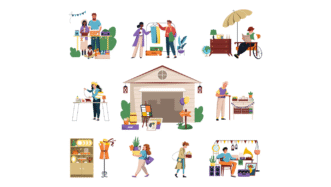LESSON OVERVIEW
With this lesson plan on expressing numbers in English, students revise numbers and learn some approximations, talk about the rising cost of living and learn some useful vocabulary.
This is a Flipped Classroom lesson plan. In a nutshell, it means that the first part of the lesson needs to be done by students at home. Learn more about flipped classroom and how we implement it in these lesson plans in our post.
PRE-CLASS ACTIVITIES
Expressing numbers in English
As it’s a flipped lesson plan, before the lesson students do three vocabulary activities. First, they have to complete seven sentences with words in the box. The words are used to describe numbers in English (e.g. a third, approximately, majority). After finishing, students need to match the words from the previous exercise with their synonyms (for example, more than – over, par – a). Finally, students get six different prices (e.g. two hundred and thirty euros, twelve dollars ninety) and they need to complete them with one word each.
IN-CLASS ACTIVITIES
Vocabulary & discussion
The in-class part of the lesson starts with a revision task in which students focus on expressing numbers in English as words in two different ways (e.g. six point three per cent, over six per cent). Then, students answer questions about amounts (e.g. How many people in your country work remotely?). After that, they complete pairs of sentences so the second sentence has the same meaning as the first sentence (e.g. pay/charge, rise/fall, costs/is worth). Then, students analyze a graph presenting average prices of some groceries in the US in 2021 and 2022, and answer some questions about the data. Next, students discuss how much some things cost in their country (e.g. a meal in a restaurant, petrol) and whether the prices have changed recently. They also say if the cost of living in their country is rising and if so, list some signs of it. This task allows them to practise expressing numbers in English. After that, students match sentence halves to create possible reasons behind the rising cost of living. Then, they look at the reasons and discuss them. The final task is only included in the teacher’s version of the worksheet. In the task, students read a text about a person struggling with the rising cost of living and brainstorm the ways he could save some money. This task provides some opportunity for students to further practise expressing numbers in English.
Subscribe to unlock these and many other Standalone lesson lesson plans with the Unlimited planWORKSHEETS












My student, who is preparing for IELTS and wants to focus on her speaking and vocabulary skills, loved this lesson! Great use of graphs and lots to discuss as it is such a topical issue.
Thanks for the great material 🙂
Thank you for your feedback! It’s always great to hear that students enjoy ESL Brains lessons.
Exactly what I needed. Thank you <3
Thanks! Really happy to hear that 🙂
This is a great lesson but…I live in the US where we use dollars and not euros. I will unfortunately have to tweak the exercises.
Hi! Thanks for your feedback. I don’t think you need to tweak anything, though. There are examples with dollars, euros and pounds in the lesson, which I don’t think should be a problem for students since the tasks don’t require them to know the currency values, just recognise the symbols $, £ and €. Besides, ex. 7 is based solely on dollars.
What a great lesson! So useful!
Thank you 😀